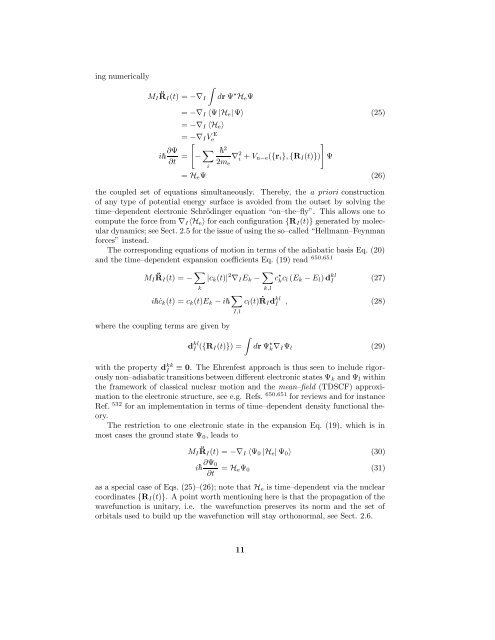Ab initio molecular dynamics: Theory and Implementation
Ab initio molecular dynamics: Theory and Implementation
Ab initio molecular dynamics: Theory and Implementation
- No tags were found...
Create successful ePaper yourself
Turn your PDF publications into a flip-book with our unique Google optimized e-Paper software.
ing numericallyM I ¨R I (t) = −∇ I∫dr Ψ ⋆ H e Ψ= −∇ I 〈Ψ |H e |Ψ〉 (25)= −∇ I 〈H e 〉= −∇ I VeE[i ∂Ψ∂t = − ∑ ]2∇ 2 i2m + V n−e({r i }, {R I (t)}) Ψi e= H e Ψ (26)the coupled set of equations simultaneously. Thereby, the a priori constructionof any type of potential energy surface is avoided from the outset by solving thetime–dependent electronic Schrödinger equation “on–the–fly”. This allows one tocompute the force from ∇ I 〈H e 〉 for each configuration {R I (t)} generated by <strong>molecular</strong><strong>dynamics</strong>; see Sect. 2.5 for the issue of using the so–called “Hellmann–Feynmanforces” instead.The corresponding equations of motion in terms of the adiabatic basis Eq. (20)<strong>and</strong> the time–dependent expansion coefficients Eq. (19) read 650,651M I ¨R I (t) = − ∑ |c k (t)| 2 ∇ I E k − ∑kk,l∑i ċ k (t) = c k (t)E k − iI,lc ⋆ k c l (E k − E l )d klI (27)c l (t)Ṙ I d klI , (28)where the coupling terms are given byd klI ({R I (t)}) =∫dr Ψ ⋆ k∇ I Ψ l (29)with the property d kkI≡ 0. The Ehrenfest approach is thus seen to include rigorouslynon–adiabatic transitions between different electronic states Ψ k <strong>and</strong> Ψ l withinthe framework of classical nuclear motion <strong>and</strong> the mean–field (TDSCF) approximationto the electronic structure, see e.g. Refs. 650,651 for reviews <strong>and</strong> for instanceRef. 532 for an implementation in terms of time–dependent density functional theory.The restriction to one electronic state in the expansion Eq. (19), which is inmost cases the ground state Ψ 0 , leads toM I ¨R I (t) = −∇ I 〈Ψ 0 |H e | Ψ 0 〉 (30)i ∂Ψ 0∂t= H e Ψ 0 (31)as a special case of Eqs. (25)–(26); note that H e is time–dependent via the nuclearcoordinates {R I (t)}. A point worth mentioning here is that the propagation of thewavefunction is unitary, i.e. the wavefunction preserves its norm <strong>and</strong> the set oforbitals used to build up the wavefunction will stay orthonormal, see Sect. 2.6.11









